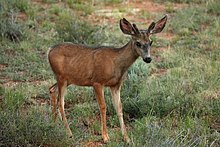
Back Capreolinae Afrikaans أيائل العالم الجديد Arabic ايائل العالم الجديد ARZ Cüyürlər Azerbaijani Capreolins Catalan Trughirsche German Capreolinae Spanish گوزنیان جهان جدید Persian Kauriit Finnish Capreolinae French
| Capreolinae Temporal range: Middle Miocene to present
| |
|---|---|

| |
| Mule deer (Odocoileus hemionus) | |
| Scientific classification | |
| Domain: | Eukaryota |
| Kingdom: | Animalia |
| Phylum: | Chordata |
| Class: | Mammalia |
| Order: | Artiodactyla |
| Family: | Cervidae |
| Subfamily: | Capreolinae Brookes, 1828 |
| Genera | |
| Synonyms | |
|
Odocoileinae | |
The Capreolinae, Odocoileinae, or the New World deer are a subfamily of deer. Alternatively, they are known as the telemetacarpal deer, due to their bone structure being different from the plesiometacarpal deer subfamily Cervinae. The telemetacarpal deer maintain their distal lateral metacarpals, while the plesiometacarpal deer maintain only their proximal lateral metacarpals.[1] The Capreolinae are believed to have originated in the Middle Miocene, between 7.7 and 11.5 million years ago, in Central Asia.[2]
Although this subfamily is called New World deer in English, it includes reindeer, moose, and roe deer, all of which live in Eurasia in the Old World.
- ^ Azanza, B.; Rossner, G. & Ortiz-Jaureguizar E. (2013). "The early Turolian (late Miocene) Cervidae (Artiodactyla, Mammalia) from the fossil site of Dron-Durkheim 1 (German) and implications on the origin of crown cervids". Palaeobiodiversity and Palaeoenvironments. 93 (1): 217–258. Bibcode:2013PdPe...93..217A. doi:10.1007/s12549-013-0118-8. hdl:11336/13861. S2CID 129071065.
- ^ Gilbert, C.; Ropiquet, A.; Hassanin A. (July 2006). "Mitochondrial and nuclear phylogenies of Cervidae (Mammalia, Ruminantia): Systematics, morphology, and biogeography". Molecular Phylogenetics and Evolution. 40 (1): 101–117. doi:10.1016/J.Ympev.2006.02.017. PMID 16584894.[permanent dead link]